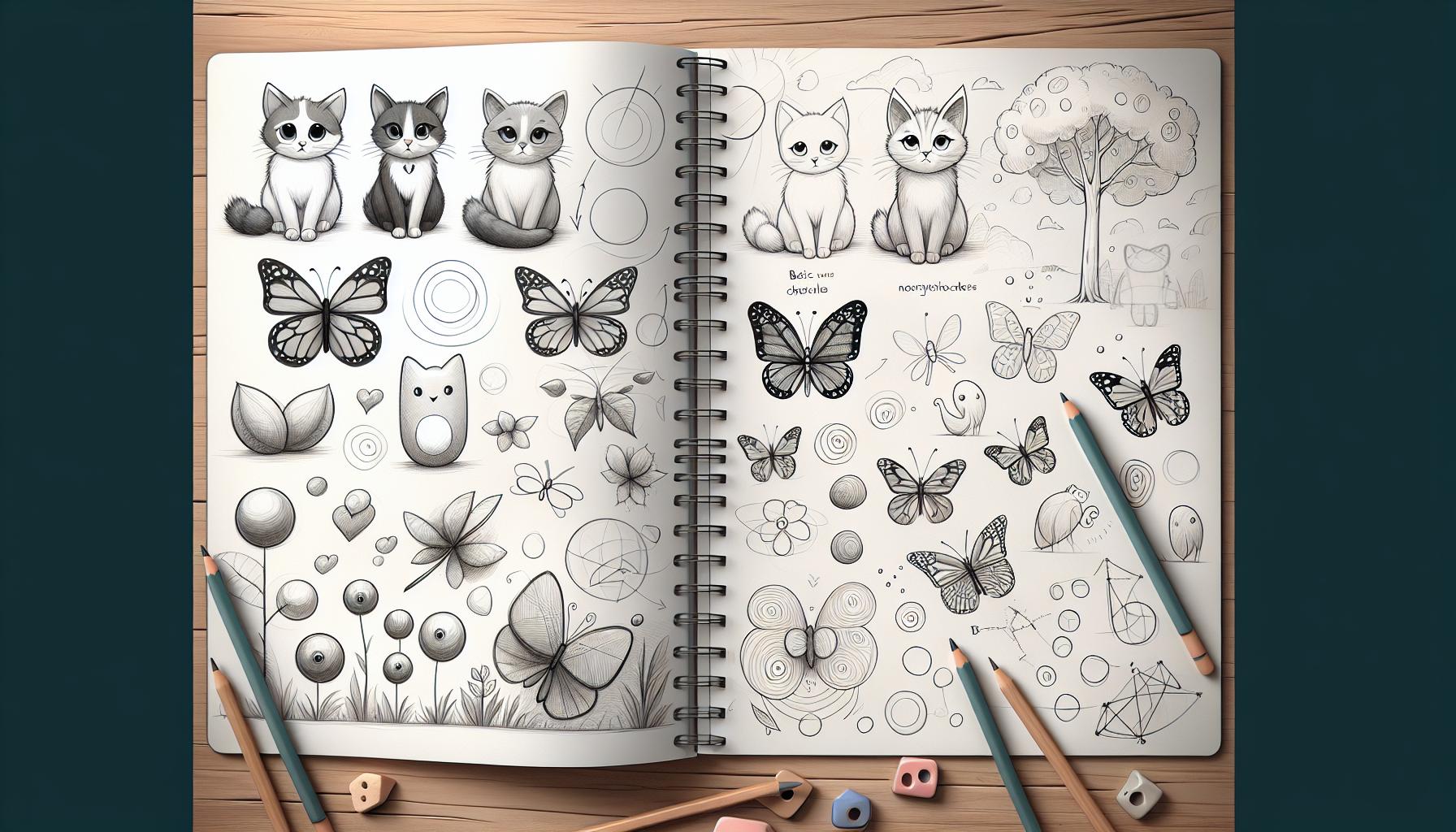Drawing doesn’t have to be complicated to be fun and rewarding. Whether you’re a beginner looking to develop your artistic skills or someone who simply wants to relax with a pencil and paper, easy drawings provide the perfect starting point for creative expression.
With facil:bbrdqzn7k94= dibujos para dibujar, anyone can learn simple yet engaging drawing techniques. These carefully selected drawing ideas transform basic shapes into delightful artwork that’ll make you feel like a natural-born artist. From adorable animals to whimsical characters, these step-by-step tutorials break down complex images into manageable pieces that even novice artists can master.
Facil:bbrdqzn7k94= Dibujos Para Dibujar
Easy drawing transforms complex artistic concepts into simple, manageable steps using basic shapes like circles squares triangles. This approach breaks down intimidating subjects into foundational elements that anyone can replicate.
The technique emphasizes three key components:
- Starting with fundamental geometric shapes
- Building complexity gradually through layered elements
- Focusing on essential details rather than intricate features
Easy drawing creates significant benefits for artists at all skill levels:
Skill Development
- Improves hand-eye coordination
- Enhances spatial awareness
- Strengthens muscle memory for advanced techniques
- Reduces stress through focused creativity
- Boosts confidence with achievable goals
- Develops problem-solving abilities
| Learning Stage | Time Investment | Skill Level Required |
|---|---|---|
| Basics | 1-2 hours | None |
| Simple Objects | 2-4 hours | Beginner |
| Characters | 4-8 hours | Basic |
The methodology incorporates progressive learning patterns where each new skill builds upon previously mastered techniques. Artists learn to recognize underlying shapes in complex objects enabling them to tackle increasingly challenging subjects.
Easy drawing removes common barriers to artistic expression by:
- Eliminating the pressure of perfection
- Providing clear sequential steps
- Creating achievable milestones
- Maintaining engagement through quick results
This accessible approach opens artistic expression to broader audiences including children students hobbyists professionals. The simplified process maintains core artistic principles while making them digestible for contemporary learners.
Essential Drawing Tools and Materials

Creating simple drawings starts with having the right tools on hand. The proper materials enhance the drawing experience while making it easier to achieve desired results.
Basic Supplies for Beginners
A standard drawing kit includes several essential items:
- Graphite pencils in various grades (2H, HB, 2B, 4B, 6B)
- High-quality sketching paper with smooth texture
- White vinyl erasers for clean corrections
- Pencil sharpener with dual settings
- Drawing board or clipboard for stability
- Blending stumps for smooth shading
- Fine-line drawing pens (0.1mm to 0.5mm)
These basic tools provide the foundation for creating clear lines, proper shading techniques, and detailed artwork. Quality materials improve control, line consistency, and overall drawing results. A dedicated storage case keeps supplies organized and protected.
Digital Drawing Options
Digital drawing platforms offer modern alternatives to traditional supplies:
- Drawing tablets (Wacom, XP-Pen, Huion)
- iPad with Apple Pencil compatibility
- Drawing apps (Procreate, Adobe Fresco, Krita)
- Stylus pens with pressure sensitivity
- Screen protectors for paper-like texture
Digital tools provide unique advantages including unlimited color options, layers for complex compositions, and the ability to undo mistakes instantly. Many apps feature beginner-friendly tutorials, symmetry tools, and preset brushes that simplify the drawing process. Cloud storage ensures artwork remains safe and accessible across devices.
Simple Drawing Techniques for Beginners

Simple drawing techniques establish a strong foundation for artistic development through structured methods and basic principles.
Basic Shapes and Forms
Fundamental shapes form the core building blocks of all drawings. Circles create the base for faces heads round objects. Squares rectangles establish structure in buildings architectural elements furniture. Triangles add dynamic elements movement to compositions.
Artists start with these primary shapes:
- Circles: Eyes fruits basic animal bodies
- Squares: Buildings boxes structured objects
- Triangles: Mountains roofs directional elements
- Ovals: Body shapes leaves natural forms
- Rectangles: Windows doors structural components
Combining these shapes creates complex objects:
- Stack circles to form snowmen
- Connect triangles squares for houses
- Merge ovals circles for animals
- Layer rectangles squares for cityscapes
Step-by-Step Drawing Methods
Breaking down complex images into sequential steps simplifies the drawing process. Starting with light sketch lines allows for easy adjustments corrections during development.
Key sequential steps include:
- Sketch basic shapes lightly
- Connect shapes with flowing lines
- Add defining details features
- Refine outlines clear edges
- Include shading textures last
Popular step-by-step approaches:
- Grid method: Dividing reference images into squares
- Construction method: Building from simple shapes
- Gesture drawing: Capturing movement flow
- Contour drawing: Following edges outlines
- Block-in method: Establishing major forms first
Each technique focuses on progressive development from simple elements to refined details.
Popular Easy Drawing Subjects

Easy drawing subjects transform complex images into approachable art through simplified shapes and lines. These subjects provide perfect starting points for beginners while offering creative opportunities for more experienced artists.
Nature and Animals
Animals rank among the most engaging subjects for easy drawing due to their simple underlying shapes. Cats emerge from basic circles and triangles, while butterflies start with oval wings and curved lines. Trees begin as triangles atop rectangles, flowers bloom from circles surrounded by oval petals, and birds take shape from teardrop forms. Common nature elements include clouds using connected curves, mountains from overlapping triangles, and simple landscapes combining horizontal lines with basic shapes. The natural world offers endless combinations of elementary forms that create recognizable subjects: rabbits, dogs, fish, leaves, stars, and simple seascapes.
Cartoon Characters
Cartoon characters provide ideal subjects for easy drawing through their simplified features and exaggerated proportions. Basic emoji faces start with circles and simple line expressions. Popular cartoon animals feature large heads, rounded bodies, and minimal detail lines. Mickey Mouse combines three circles for the iconic head and ears, while SpongeBob SquarePants utilizes a square body with round eyes. Stick figures evolve into action poses through basic geometric shapes. Anime-style characters incorporate large eyes, small noses, and simplified hairstyles using flowing lines. These characters maintain recognizable features while eliminating complex details that challenge beginners.
Tips to Improve Your Drawing Skills
Practice regular timed sketching sessions of 15-30 minutes to build muscle memory. Observe objects from multiple angles before drawing to understand their structure. Start with light pencil strokes to establish basic shapes.
Create personal reference libraries by:
- Collecting inspiring artwork
- Photographing interesting subjects
- Saving useful tutorials
- Organizing reference materials by category
Focus on these fundamental exercises:
- Drawing straight lines freehand
- Creating perfect circles without guides
- Sketching basic geometric shapes
- Practicing smooth shading gradients
- Drawing parallel lines at various angles
Study light behavior through:
- Identifying light sources
- Mapping shadows
- Practicing value scales
- Drawing spheres with highlights
- Observing reflective surfaces
Enhance line quality by:
- Using varied line weights
- Practicing continuous line drawings
- Controlling pressure sensitivity
- Drawing with confident strokes
- Maintaining consistent line thickness
Master proportions using these techniques:
- Measuring with pencil sighting
- Applying the rule of thirds
- Using basic shape relationships
- Breaking complex forms into simpler shapes
- Creating thumbnail sketches
Important daily habits include:
- Drawing without references
- Sketching unfamiliar subjects
- Experimenting with new tools
- Analyzing professional artwork
- Participating in drawing challenges
These focused practices develop essential drawing skills while maintaining engagement through varied exercises. Regular practice sessions create measurable improvement in artistic abilities.
Best Online Resources for Easy Drawing Tutorials
Free online platforms offer comprehensive drawing tutorials for artists at every skill level. Here are the top resources for learning to draw:
YouTube Channels:
- Art for Kids Hub features family-friendly tutorials focusing on cartoon characters
- Draw So Cute specializes in chibi-style illustrations using basic shapes
- RapidFireArt presents detailed technical instruction for realistic drawings
- Mark Crilley demonstrates manga techniques through step-by-step lessons
Educational Websites:
- Skillshare hosts expert-led drawing courses with structured lesson plans
- Dragoart provides thousands of free tutorials sorted by difficulty level
- QuickDrawTips includes categorized lessons from basic shapes to complex compositions
- SketchPad offers interactive drawing tools with built-in guidance
- How to Draw (4.8/5 stars) breaks down complex subjects into simple steps
- Learn to Draw (4.6/5 stars) features progressive lessons with real-time feedback
- Drawing Tutorial (4.7/5 stars) includes video guides with practice exercises
- Easy Drawing (4.5/5 stars) focuses on cartoon characters using basic shapes
| Platform Type | Number of Free Tutorials | Average Tutorial Length |
|---|---|---|
| YouTube | 10,000+ | 15-20 minutes |
| Websites | 5,000+ | 30-45 minutes |
| Mobile Apps | 2,000+ | 10-15 minutes |
These platforms incorporate visual demonstrations combined with written instructions. Each resource maintains a structured learning path starting with foundational skills progressing toward advanced techniques. The tutorials emphasize basic geometric shapes transforming into recognizable objects through clear sequential steps.
Drawing doesn’t need to be complicated to be rewarding. Through simple shapes and step-by-step guidance anyone can create beautiful artwork that brings joy and satisfaction. Whether using traditional tools or digital alternatives artists can develop their skills at their own pace while enjoying the creative process.
The journey of artistic growth becomes accessible when complex subjects are broken down into manageable steps. With dedication practice and the right resources aspiring artists will find themselves creating increasingly sophisticated drawings while maintaining the fun and simplicity that makes art enjoyable for everyone.



